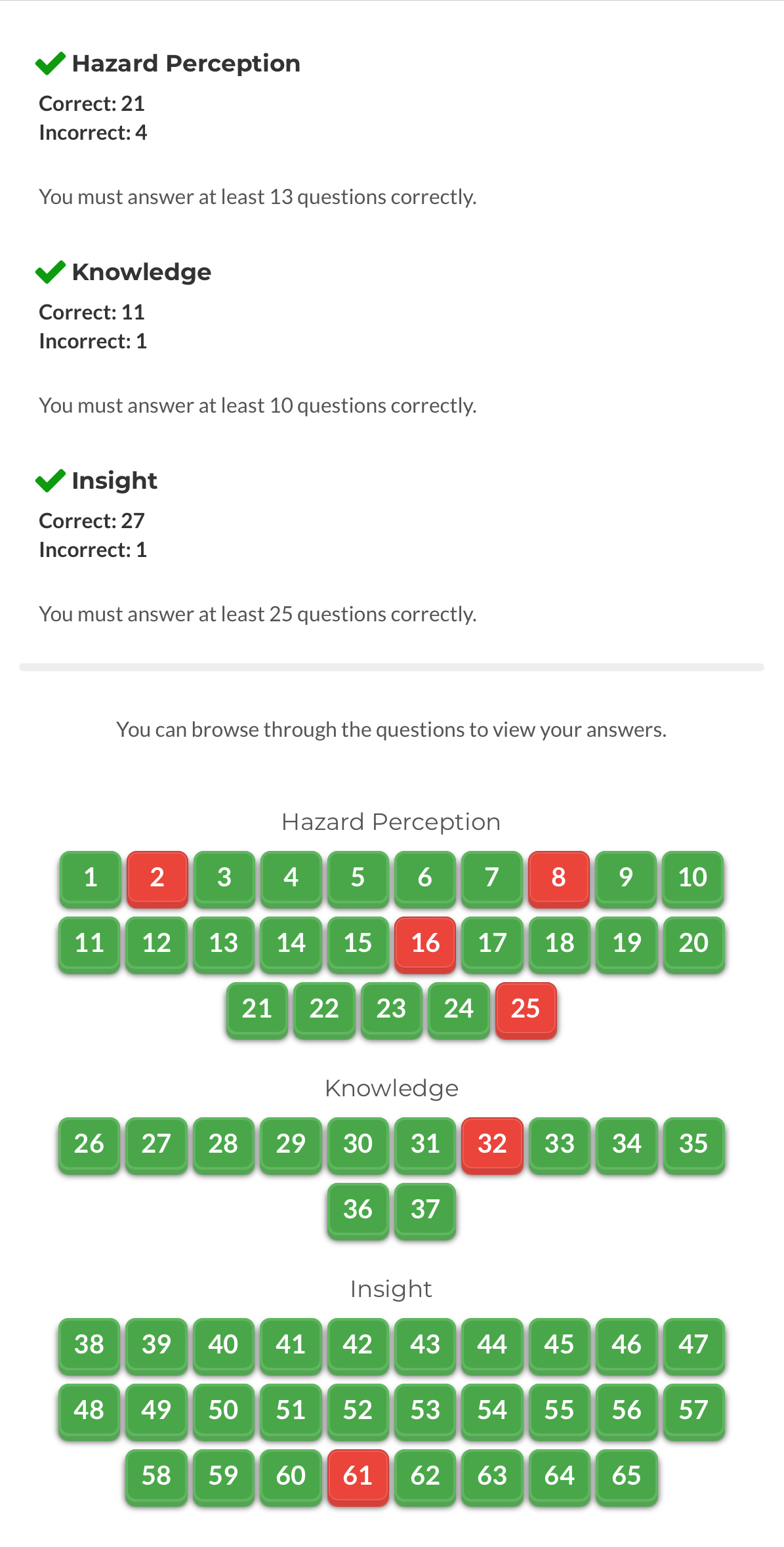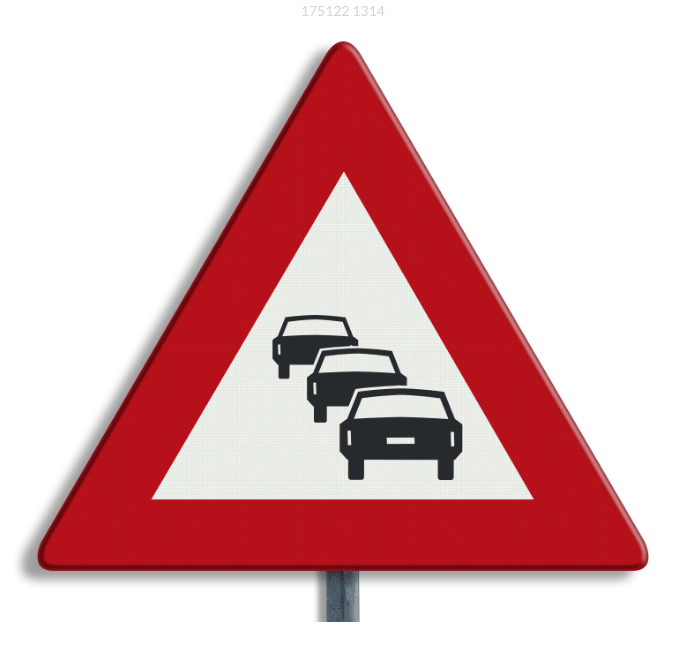First round of review, these are the sections I should focus on.
Intro
1.1 Road Users => convoy signs
1.3 Road, road sections, and markings
Hazard recognition
2.1 Hazar recognition, 5 steps & 2.1 Risk factors
Using the road
3.1 Getting in and out => in from the front / out from the back.
Blind spot => review several times !! (It’s counter-intuitive)
3.4 Coming across => incoming traffic
3.8 Stopping, standing still, and parking
Important tips for special maneuvers (these are the rules)
Priority
4.1 Priority => right has priority. longest turn comes after the shortest one (this is when two drivers come from the opposite direction and try to turn to the same direction, since both are at the right of each other, the widest turn is considered the driver on the left)
4.2 Behavior at intersections & 5 steps of cross road intersection safety
4.3 Special priority rules => Tram priority rules & Military convoys and funeral processions priority rules
4.4 Letting others first => Is it better for road safety to let others go first? Then do it. / 10 tips for safely giving the way to priority vehicles
Recognizing roads
- Access roads
- Distributor roads
- Arterial roads
- 5.2 Highway
- 5.3 Freeway (worth splitting)
5.5 Turning / Centrifugal force
5.7 Erf => 15kmh / exiting
5.9 Level crossing => distance signs
Rulezzz
Instructions from police officers and traffic controllers
> Traffic lights
> Traffic signs or markings on the road
> Traffic rules.
Vehicle & behavior
7.1 Ride preparation and exterior vehicle inspection
7.2 Vehicle Dashboard and Interior Check => consider splitting
7.3 Steering wheel, seats, and mirrors
7.4 Seat Belts and Child Car Seats
7.5 Checking and using lights => consider splitting
7.6 Use of signals => blue vs. yellow/green lights
10.2 Trailer design requirements
Responsible and environmentally conscious driving
Article 5:
The general standard (or norm): You may never behave on the road in such a way that you (potentially) obstruct or endanger others.
8.2 Medication, alcohol and drugs
- Are the levels of alcohol checked in the exam?
- Points system: 1 point per DUI. 2 points (within 5 years), license revoked.
8.4 Defensive and Social Behavior
- Adaptive: align with the traffic
- Assertive: without hesitation, safety over rules
- Defensive: other’s mistakes into account
- Social: part of the whole
8.5 Breakdown on the road (towing) & Towing
8.6 Response in emergency situations => split !
8.7 Driving in all weather conditions => split
Environmental zones => split
Documents
Are these sections included in the text?
9.2 Driving Licenses => types & points / split !!!
9.3 License plates and vehicle registration certificate
Notes from practice examn
- Fog lights aren’t mandatory, only recommended.
- Rear fog logs are required though.
- 5.3 Freeway => max speed limits (ie. 100kmh during day) still require signs? 130kmh is the “max legal speed”, the 100kmh during day is an exception.
- Exit lane (deacceleration) is not part of the main carriageway
- Animals ambulance is not a priority vehicle
- Stand still (ie. temporary stop) is allowed anywhere in the erf
- Cosmetic damage is not an emergency ! (i.e do not stop on emergency lage)
- Speed pedelec (ie. e-bike?) follows rules of moped / cycles (ie. no bike-path)
- This is when they have a license
- #question bike vs. cycle?
- Load vehicles markings (+3500kg)
- Trailed and semi-triller => red from, yellow filling
- Lorry => red and yellow stripes
- Traffic queue sign => increase following distance and adjust speed, warn traffic behind with with hazard light
- At priority uncontrolled junctions even pedestrians go first (vs. those turning). Because ALL traffic going straight must go first.
- ‼️ All junctions where the right of way is not controlled by traffic lights, traffic signs or road markings are priority uncontrolled junctions. It does not matter if one of the roads seems less important because it is narrower or is only accessible for certain road users.
- Eg. here the pedestrian is considered to continue straight and thus the motorcycle goes last of all
- The car and the mopped do go before the pedestrian because they are drivers
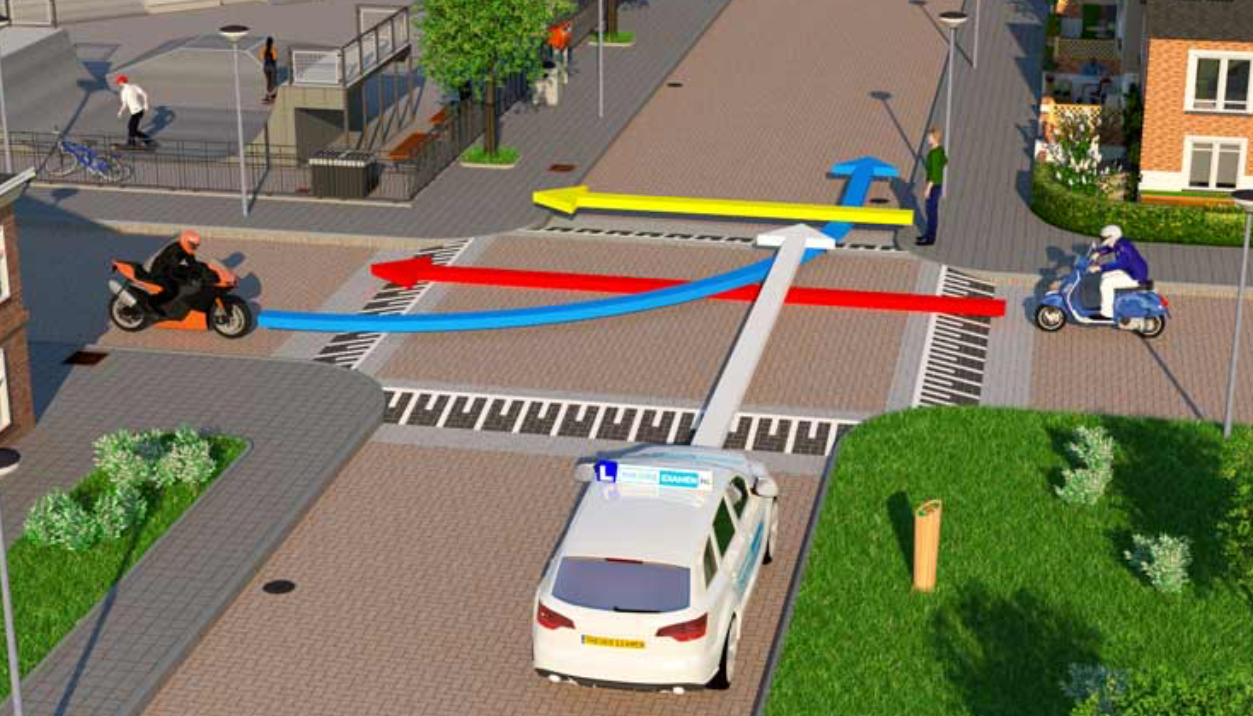
- Agricultural vehicles often have poor lights 🔅
- APK certificate is not required on the car
- People with horses, even when on foot, are considered drivers
- Shifting gears (most optimal)
- Petrol: ~2k rpm
- Diesel: ~1.5k
- Using the whole merge lane (acceleration lane) is not necessary
- You can drive over chevrons if they are on the rush-hour lane and the lane is open
- Military convoy:
- You can cut a military convoy or funeral procession if you are on the priority road.
- Pedestrians cannot cut through convoys, even through the pedestrian crossing.#todo double check
- You can overtake on turns/bends (not recommended though, ie. not wise)
- Overtaking just to then stop is not allowed, since you’ll make the traffic behind slow down (ie. you are hindering them)
- Go to a mechanic: indicates something wrong with alternator, power cables, or drive belt.
- Is it not low battery? 😱
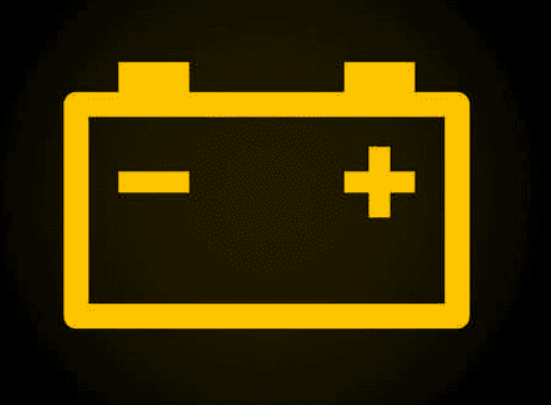
- You can use dashed/broken lines bike lane to position for a turn, as long as there are no bike line users behind you (it’s fine if they are in front). It is actually preferred because you will obstruct the road much less
- When highway/expressway are busy drive along, in the merge lane, and join when possible. Do not stop or use turning lights.
- Only stop if you get to the end of the merge lane and weren’t able to join yet
- Horses might ride on the carriageway or the roadside when there’s bridle.
- Rear fog light is required on trailers (put on operation after 31 Dec 1997)
- Heavy trailer affects position of the headlights (point more upward)
- If there are two speed signs (eg. matrix and sign) the lower applies
- Fatigue reduces perception (and probably reaction time but more so perception)
- 80kmh = 5th gear. 50kmh = 4th gear (to get lower rpm)
- Under-inflation increases risks of skidding
- You cannot overtake on the right even when going in your own lane (ie. if the left is slower you have to go slow as well)
- When transporting heavy loads, the car tilts more when you turn. It also takes longer to break, but the effect of tilting when turning is more important.
- Short adults can use a belt guide, they cannot use a hip-only belt or the belt under their arm.
- When overtaking, move completely to the left lane (or right if exception allows), even what it’s a motorcycle or narrow vehicle.
- Parking prohibition signs only apply to the side of the road they are placed in. However “zone” turns it into a prohibition for both sides.
- A parking prohibition zone doesn’t apply to parking spaces within the zone
- You can stop (only to pick/drop passengers and load/unload goods) on a P area for a different vehicle type or disabled people
- Stopping is not permitted on or next to a bus lanes. Ie. ”(lijn)bus’ lanes
- You might stop on tram rails as long as you don’t obstruct the tram
- However, you can sort to turn on the tram tracks (when they are part of the carriageway) even when the tram is coming behind
- Overtaking ban of motor vehicles also accounts for motorcycles and micro cars (brommobiels)
- No full beam headlights during the day
- Trailer license plates (even the white ones) require a quality mark
- Dashed cycle lanes lanes are “suggested” lanes (when there’s no 🚲 marking either), you can park there if not obstructing anybody
- Snow chains are NOT allowed in The Netherlands
- When there are strong cross winds, it’s better to slow down and also steer in the direction of the wind (if possible, I guess)
- You can overtake on the right not only on the roundabout but also when approaching it
- The roundabout “area” is easily recognizable (eg. there are traffic islands)
- You have to wait for license suspension to end before you can drive again, even with an instructor.
- Turning at a junction is not a special maneuver (duh!)
- You can overtake near level crossings, as long as it doesn’t cause danger.
- Verge is also part of the road. Stopping on the verge requires no lights
- Funeral processions and military convoys
- Take priority on priority uncontrolled junctions!
- Do not have to give way to pedestrians at pedestrian crossings
- ‼️ You only have to give way to all road users if you have to leave the erf via an exit construction
- STOP sign: only give the way to drivers on the crossing road
- Only rear license plate must be lit in the dark
- Side lights are only mandatory when you park/stop at night outside built-up areas.
- You can park outside the built-up area along the side of the road (I guess this is the verge, not the carriageway)
- Agricultural vehicles and motor vehicles with a limited speed must be fitted with a triangular retro-reflector on the rear.
- Victims in shock should not drink
- Bromobiel is not a motor vehicle (but it is a motor carrier?) ‼️
- A driver must at all times be able to bring his vehicle to a standstill within the distance that he can see the road to be clear. In other words, always drive with a speed with which you can stop safely within the limit of your vision.
- When overtaking return to the lane when you can see the front of the car through your interior mirror.
- Drivers license suspension still allows riding a bike. But driving prohibition prevents bike riding.
- Lorri with trailer: 18.75m max length ‼️
- Lorri (tractor) with semi-trailer: 16.5m
- Officer
- Hand pointing (my) right is front traffic
- Hand point (my) left is behind traffic
- Max speed is for optimal weather conditions, with poor conditions you should slow down
- You can stop on garage entries to let priority vehicles go first
- 15% accidents are caused by fatigue
- CPR: 2 breaths every 30 chest compressions
- Distance formulas:
- Following:
(velocity / 2) + 10% - Reaction:
speed / 10 * 3 - Breaking:
(speed / 10) * (speed / 10) / 2 - Stopping:
reaction distance + breaking distance
- Following:
- Polder blindness: When you drive for a long time through a monotonous landscape, you can suffer from polder blindness. You receive few stimuli when you drive for a long time through a boring and monotonous landscape (such as a polder landscape). This can lead to a loss of alertness and concentration. Polder blindness can be very dangerous when something unexpected happens that you have to react to quickly.
Signs
Local traffic
“Except local traffic”
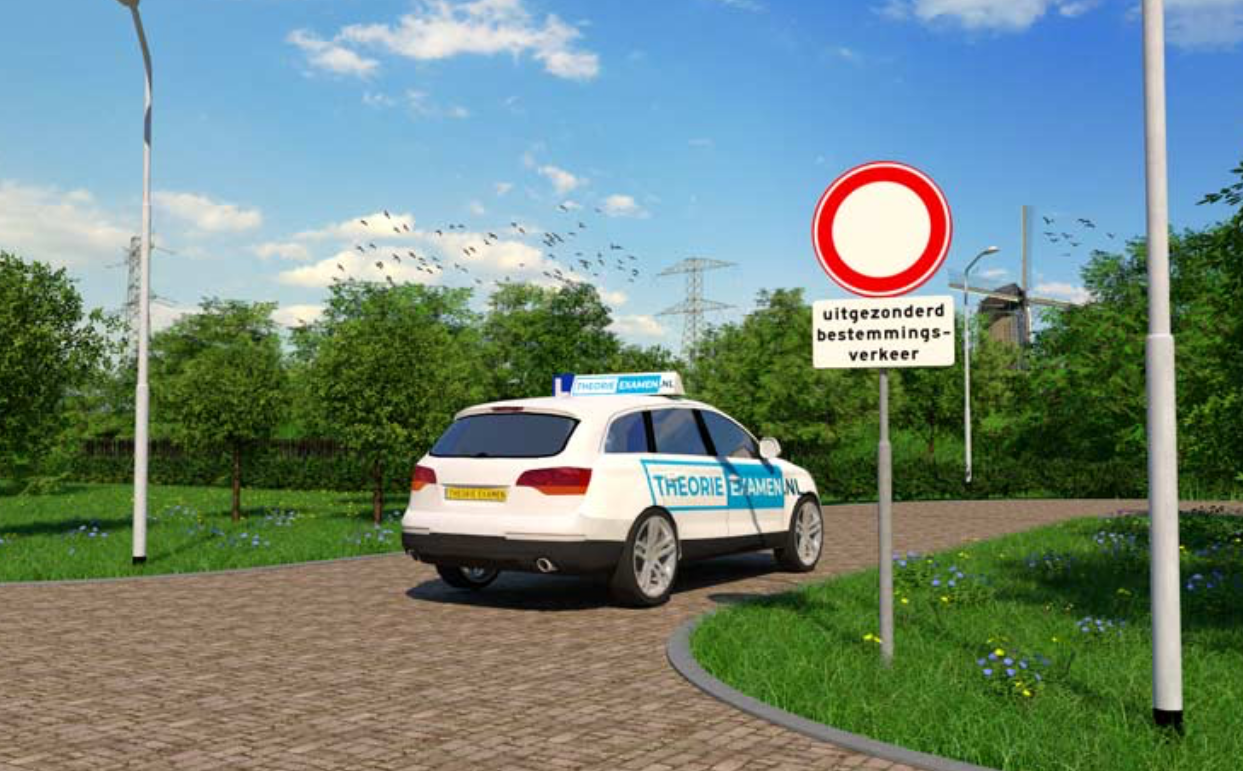
Exits
Going through an exit construction is an Special maneuver !
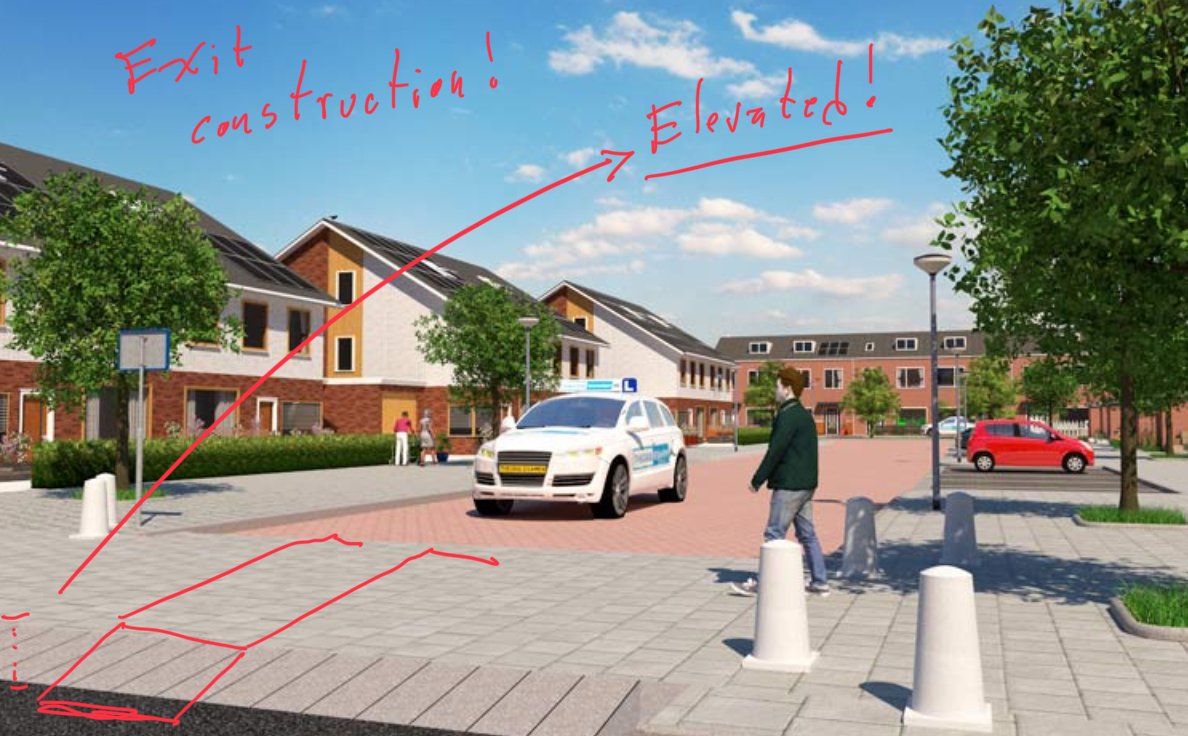
Exit sign as well:

When approaching T-junction
One way street (you won’t see traffic coming from the left):

You must turn to the left (but traffic might come from the left)
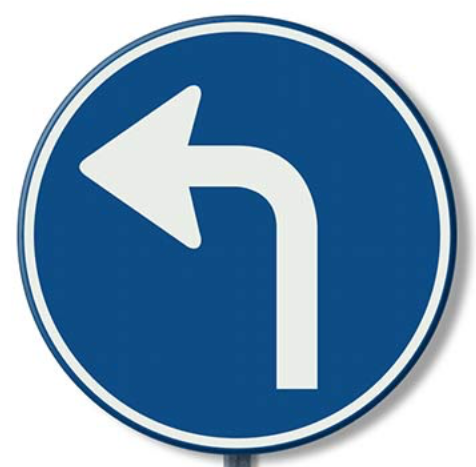
Road types
E-road stands for European road
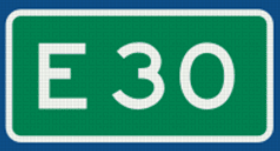
N-road is a provincial road (motorway / autoweg)
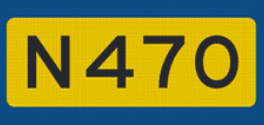
A-road is a motorway (or freeway / autosnelweg)
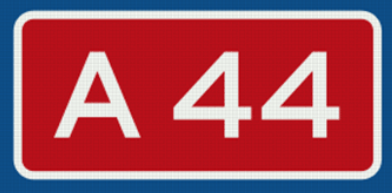
Moped driver has to go in cycle/moped path.
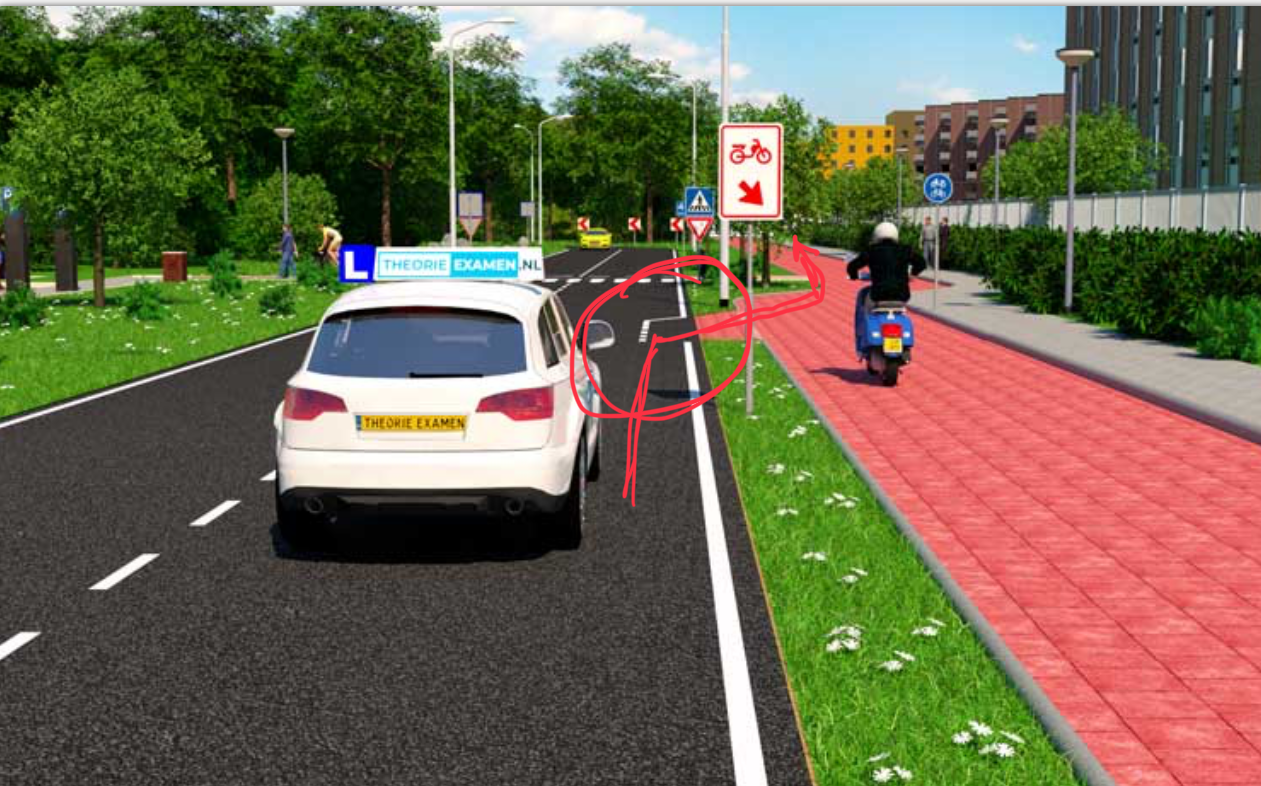
Priority
‼️ Traffic turning has to give priority to traffic continuing straight on THEIR same road.
IMPORTANT: if the priority sign denotes a turn, the vehicles continuing on the priority road (ie. turning along) are considered to go “on the same road”, thus go first.
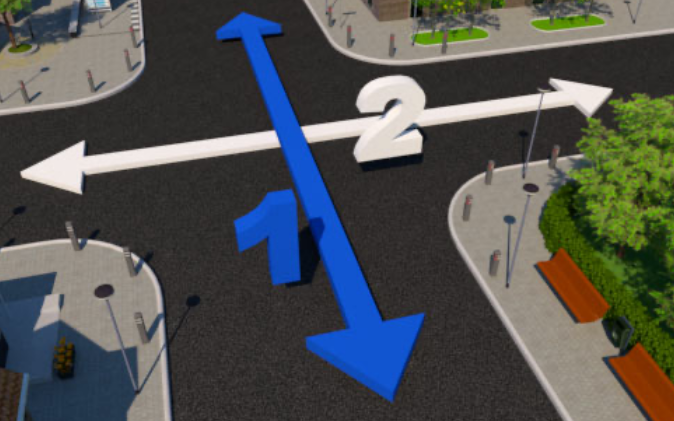
Here car is turning from road 1, pedestrians goes straight on road 2. Car goes first. They are on different roads.
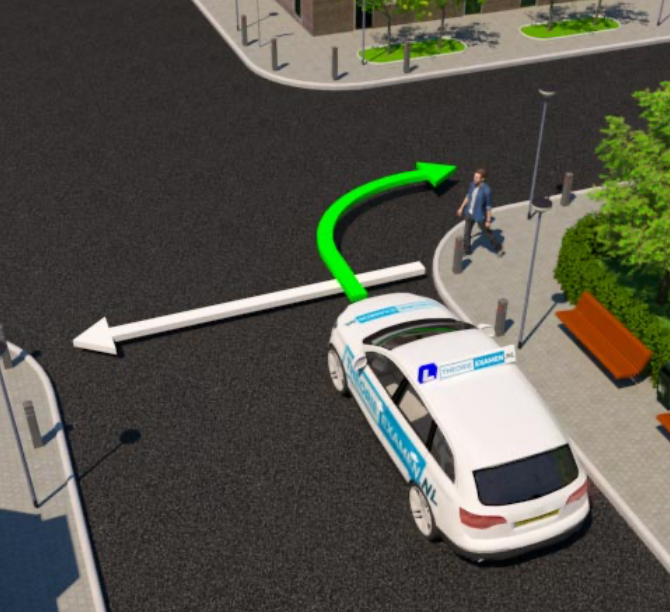
But here, pedestrian goes straight on road 1 and car is turning from road 1. Pedestrian goes first. They are on the same road.
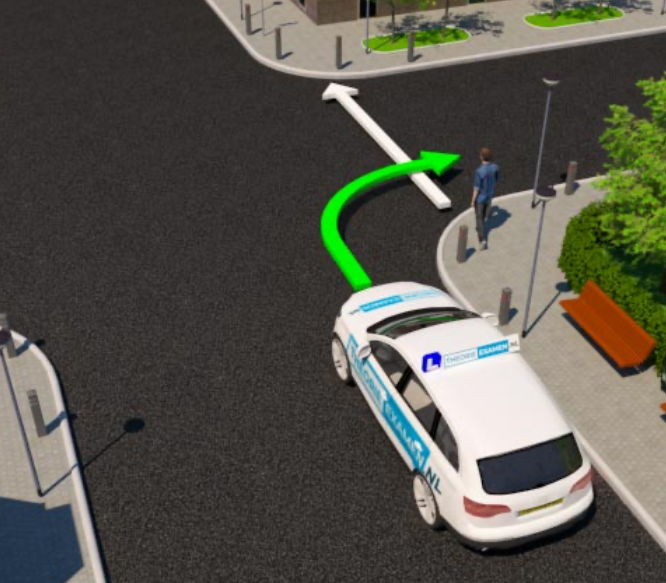
The thick black line indicates which road has priority. the short, thin lines indicate who gives priority.
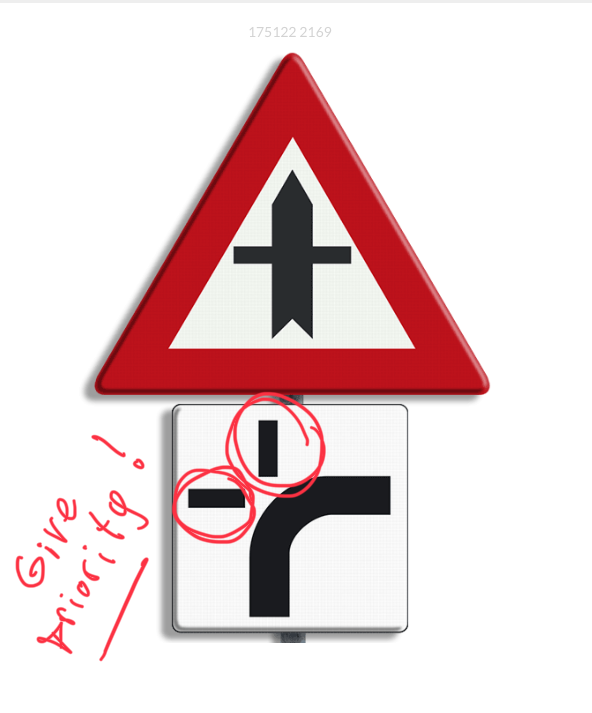
- Police car, car, motorcycle.
- Car gives the right
- Motorcycle turns, car goes straight
- Police car doesn’t cross motorcycle
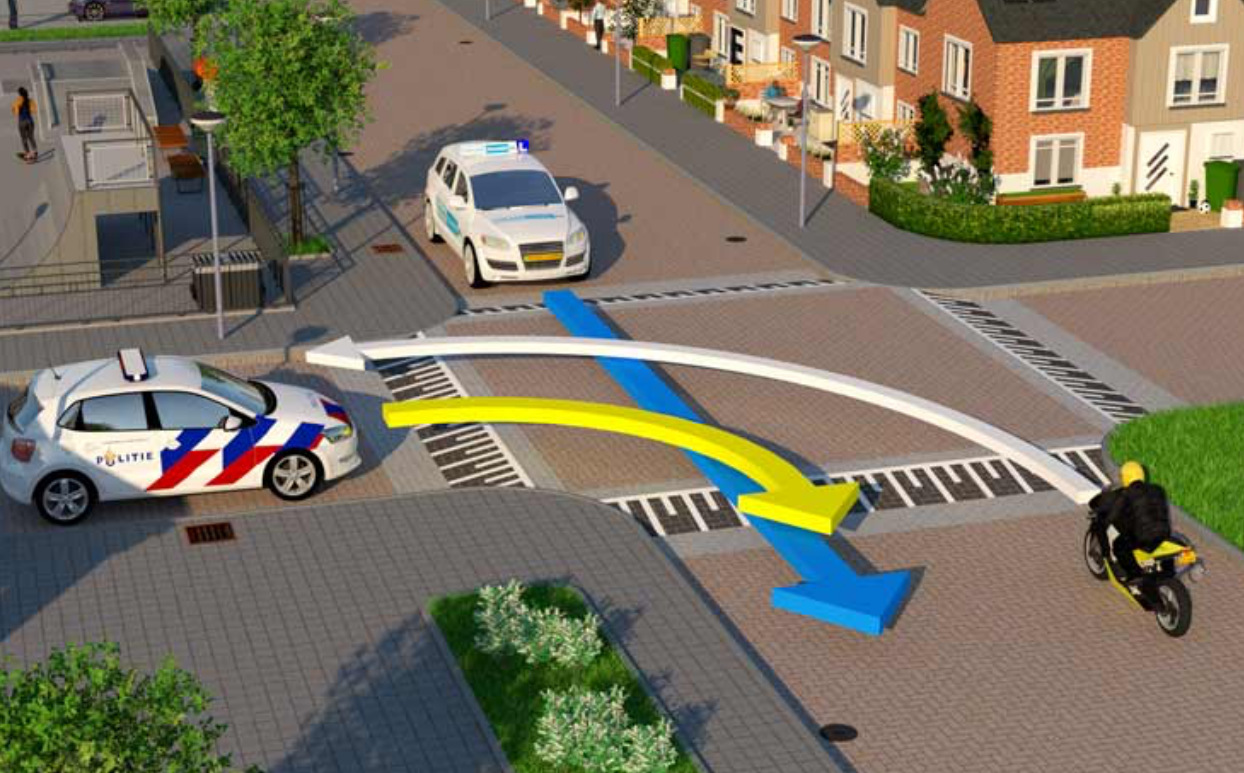
- Motorcycle, car, van
- Uncontrolled junction, right takes priority
- Exception: car is on unsurfaced road
- Van gives right to motorcycle
- Left (long) turn goes after right (short) turn: van goes after car
- This applies even between paved and unpaved road
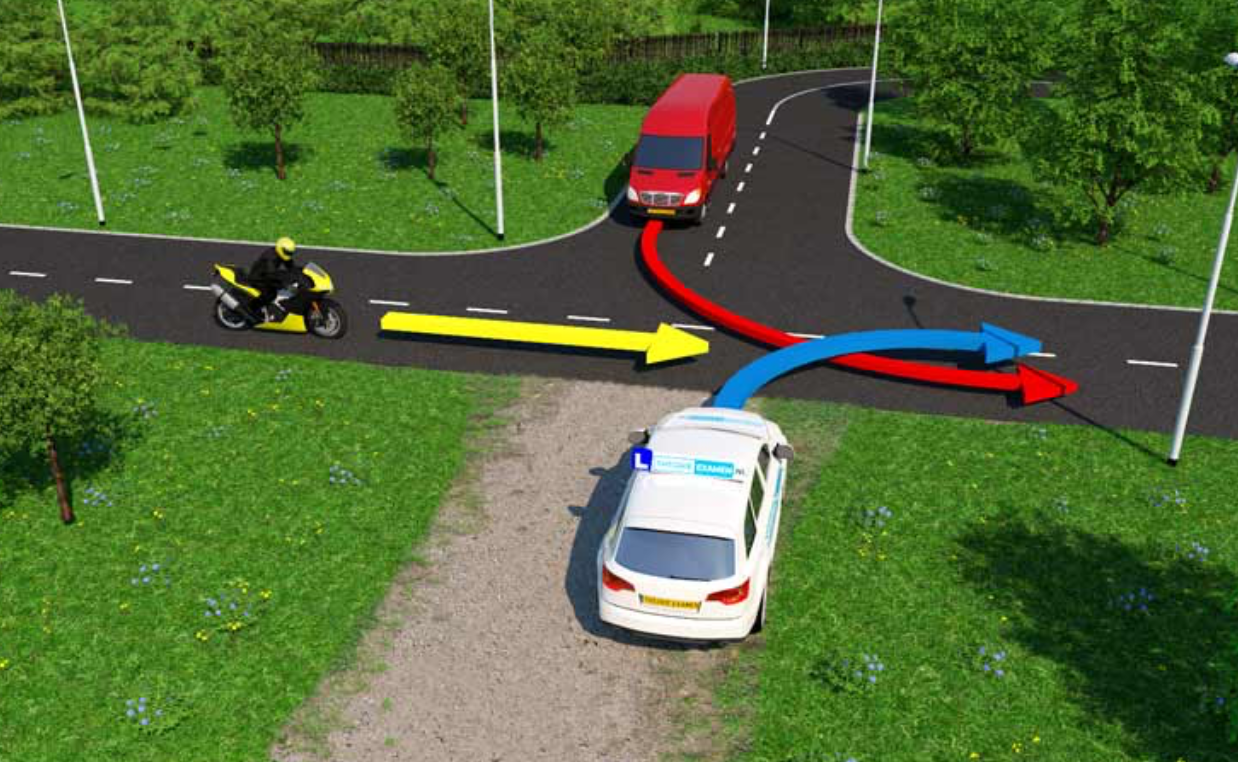
- Van, motorcycle, car
- Car is behind shark teeth, the other two take priority
- Left turn goes after straight traffic: van before motorcycle
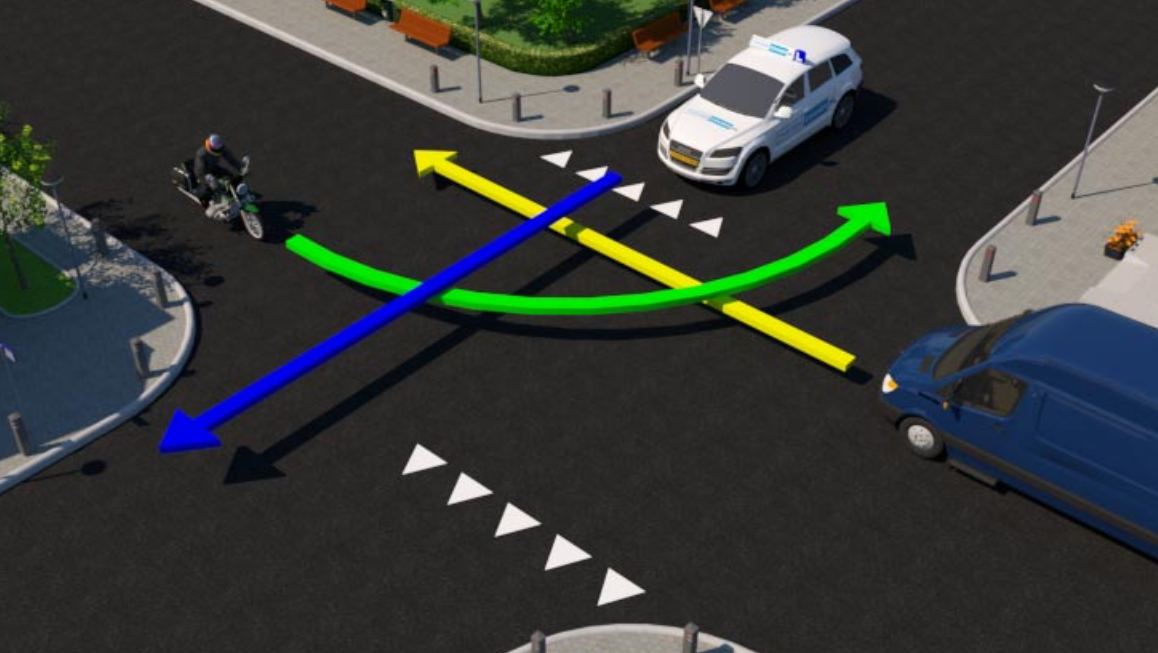
Priority uncontrolled junction, thus the bike goes first

Cyclist goes straight on the same priority road, you turn after him.

- Pedestrian, car
- Pedestrian goes straight “in the roundabout”
- Car is turning from the roundabout
- They are on the same road
:troll:
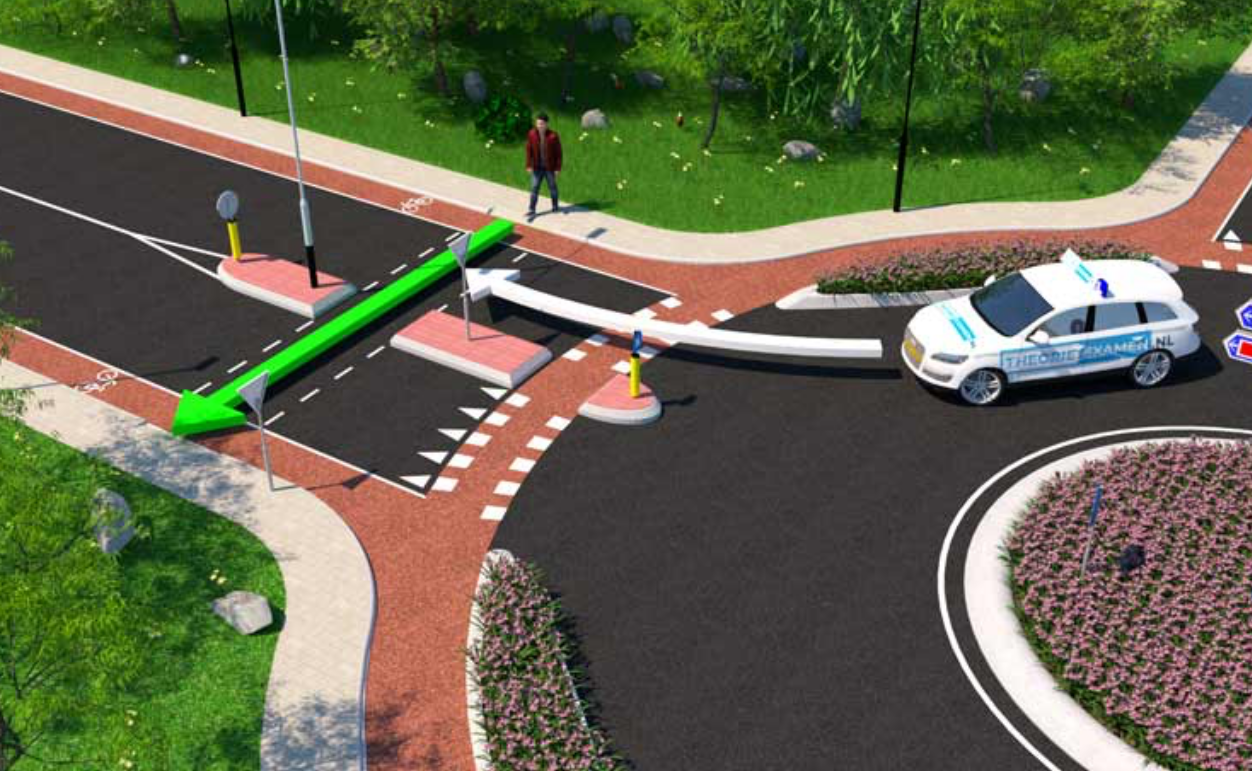
- Gray car, white car
- Both go through the exit, special maneuver
- The gray car leaves firs to give room for the white car to enter
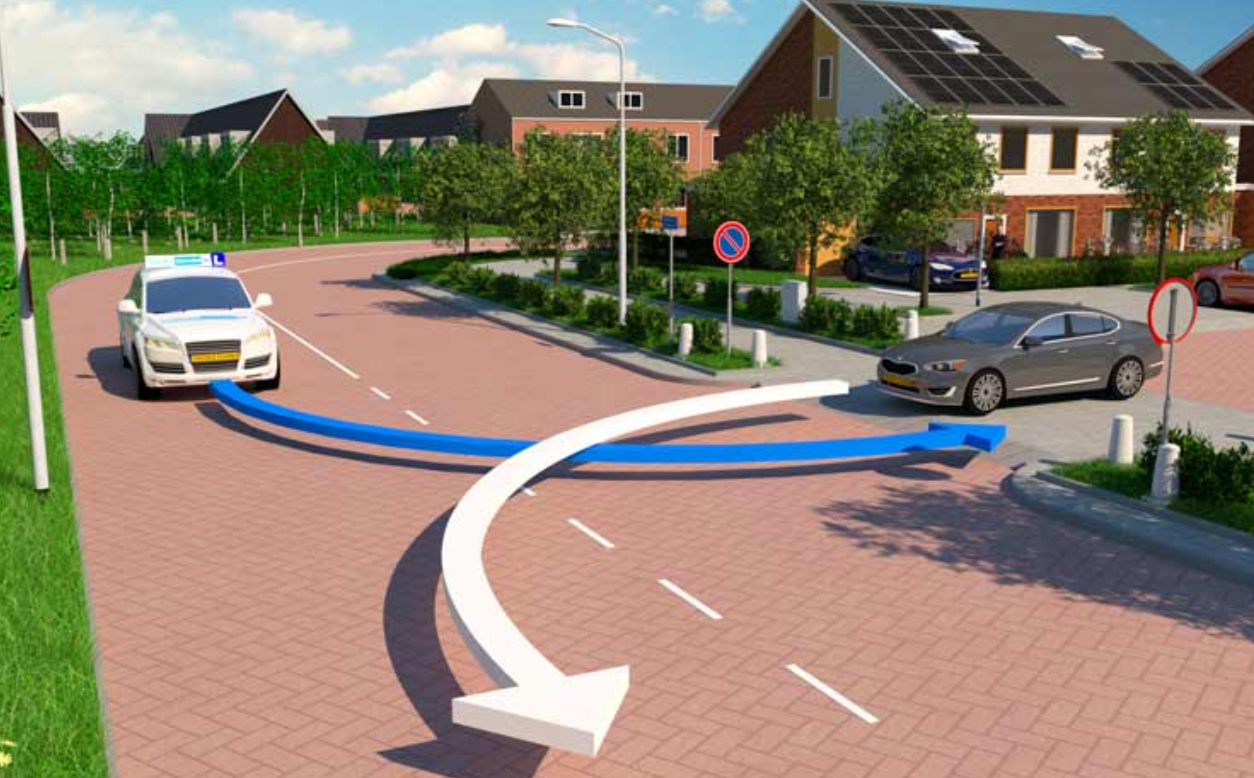
- Pedestrian, agricultural vehicle, cyclist, car
- Cyclist goes straight
- Car and cyclist give right to tractor
- Pedestrian goes straight in same road as tractor
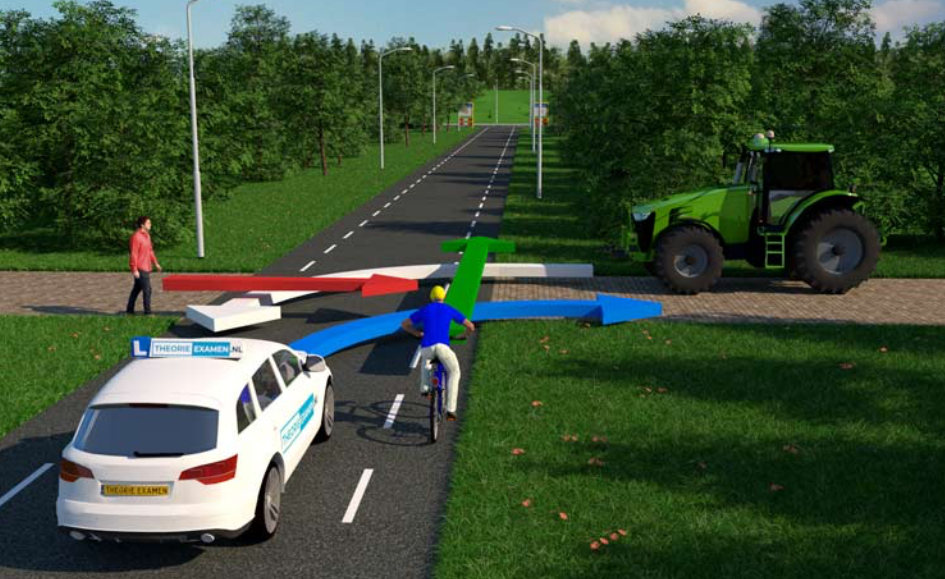
Only let drivers go first when coming off unpaved road
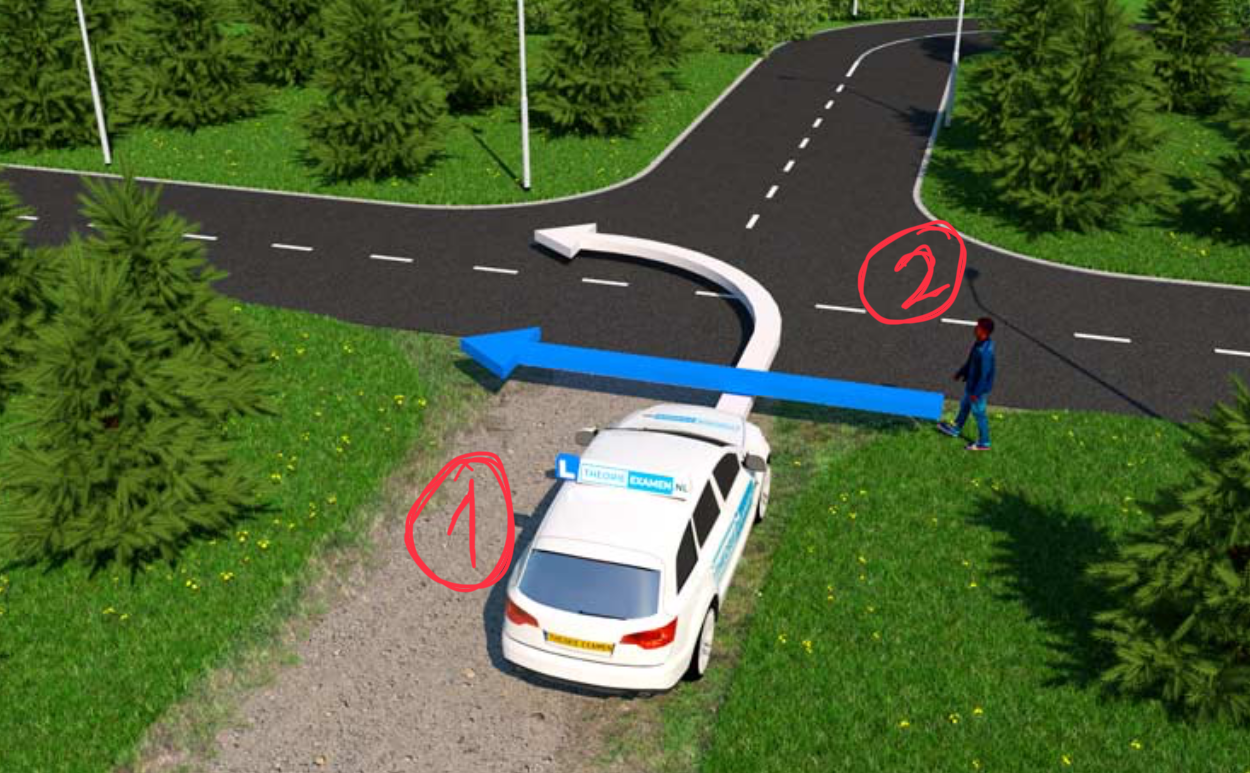
At priority uncontrolled junctions, drivers must give way to drivers approaching from the right. The motorcycle must also give way to the car and the car must give way to the moped. So the moped goes first, then the car and after that the motorcycle.
The pedestrian walks straight ahead on a different road than the turning motorcyclist. The moped rider and the motorcyclist do not have to give way to the pedestrian. So the pedestrian goes last.
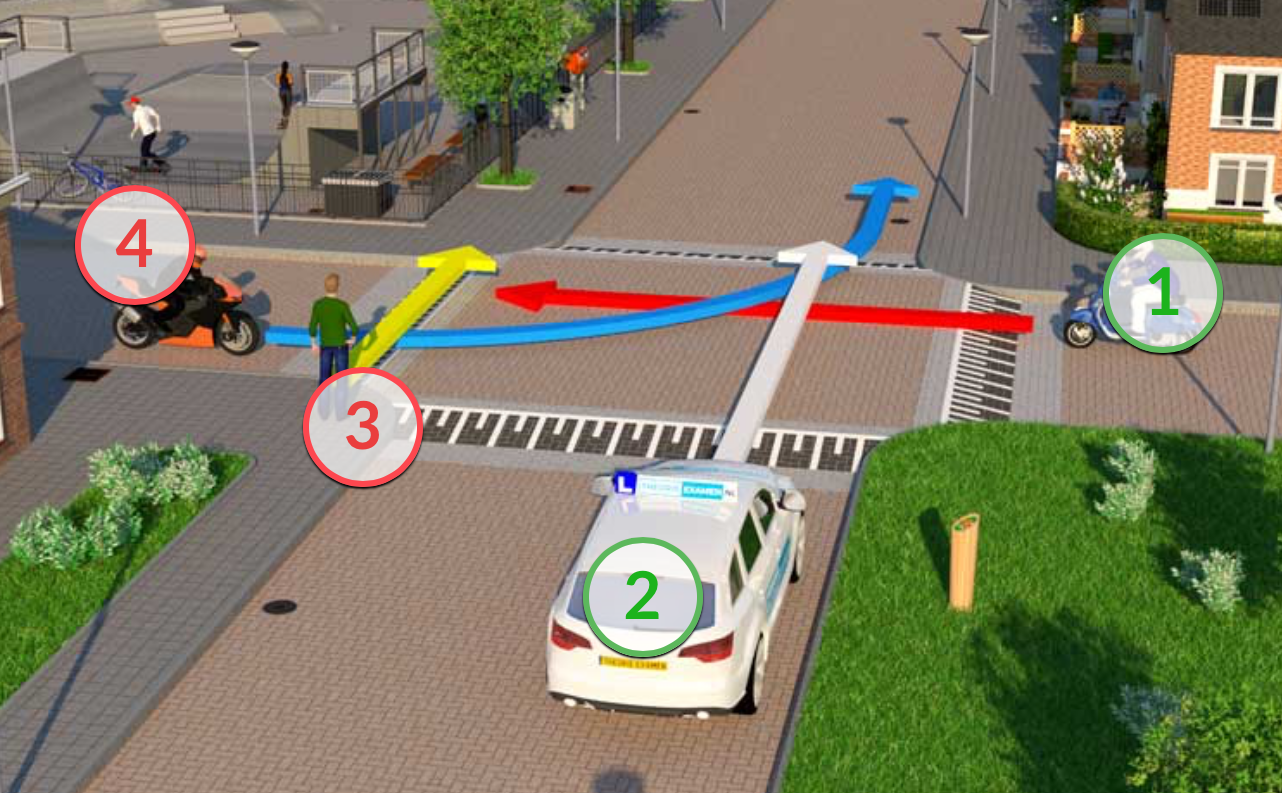
🤯
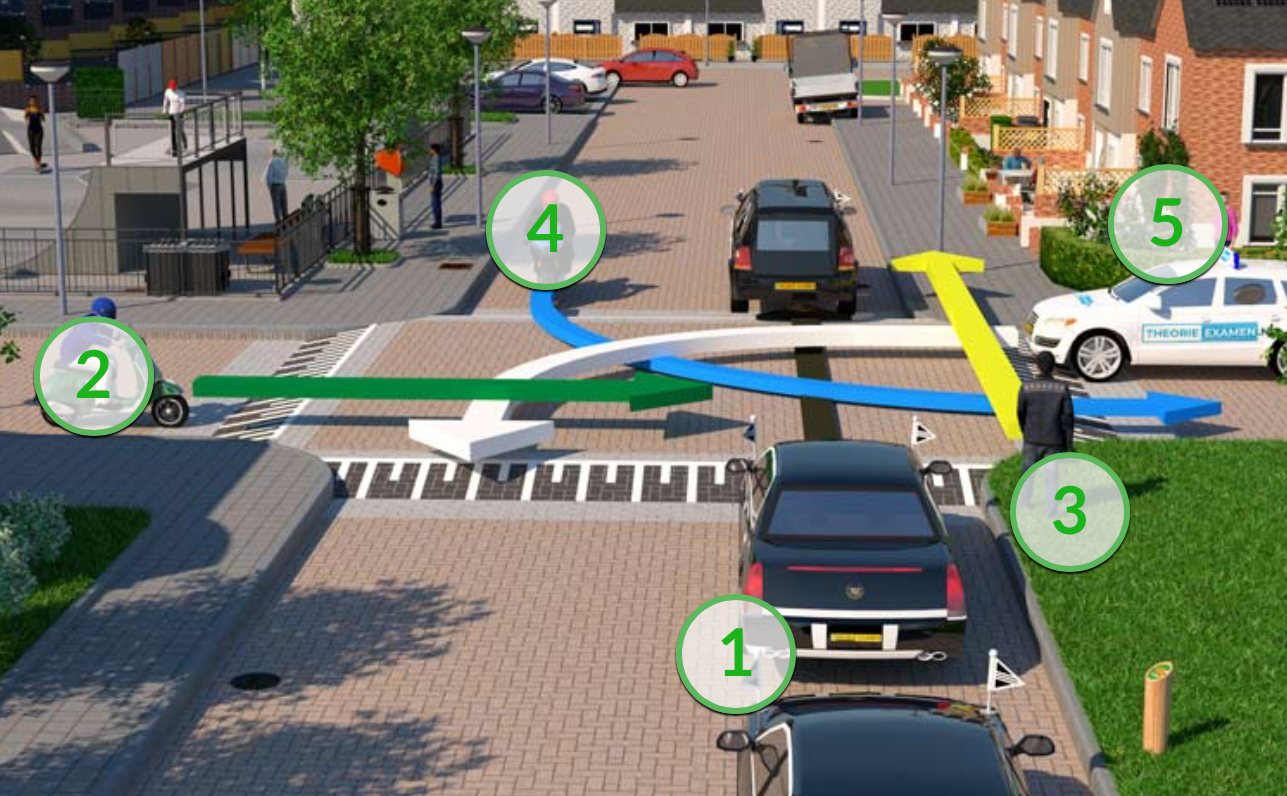
Car turns right so van has to give it priority (it’s turning left) regardless of type of road surface
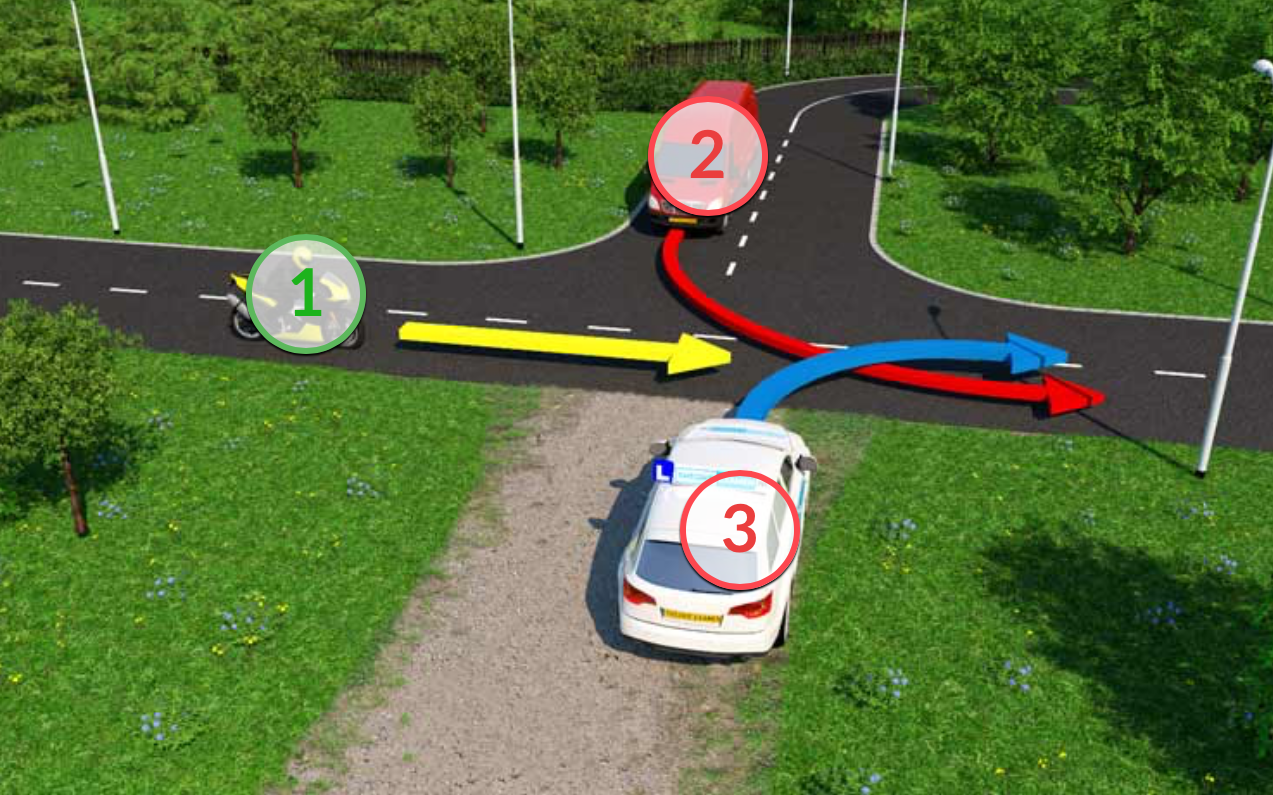
Mopped first, it’s on the right of the orange car
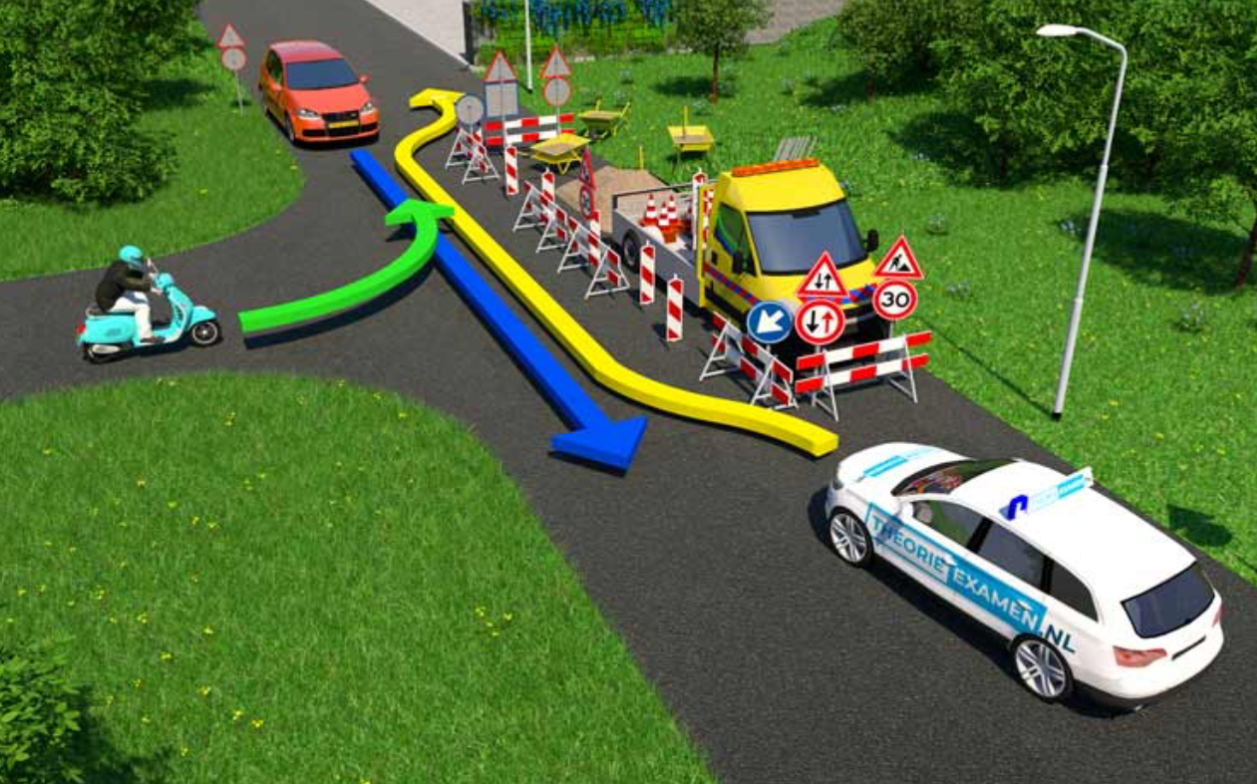
At a priority uncontrolled junction, drivers must give way to drivers approaching from the right. The military convoy must therefore give way to the car and the car must give way to the motorcyclist approaching from the right. The motorcyclist goes first. The car has to give way to the pedestrian continuing straight ahead on the same road. The pedestrian therefore goes second, followed by the car and finally the military convoy.
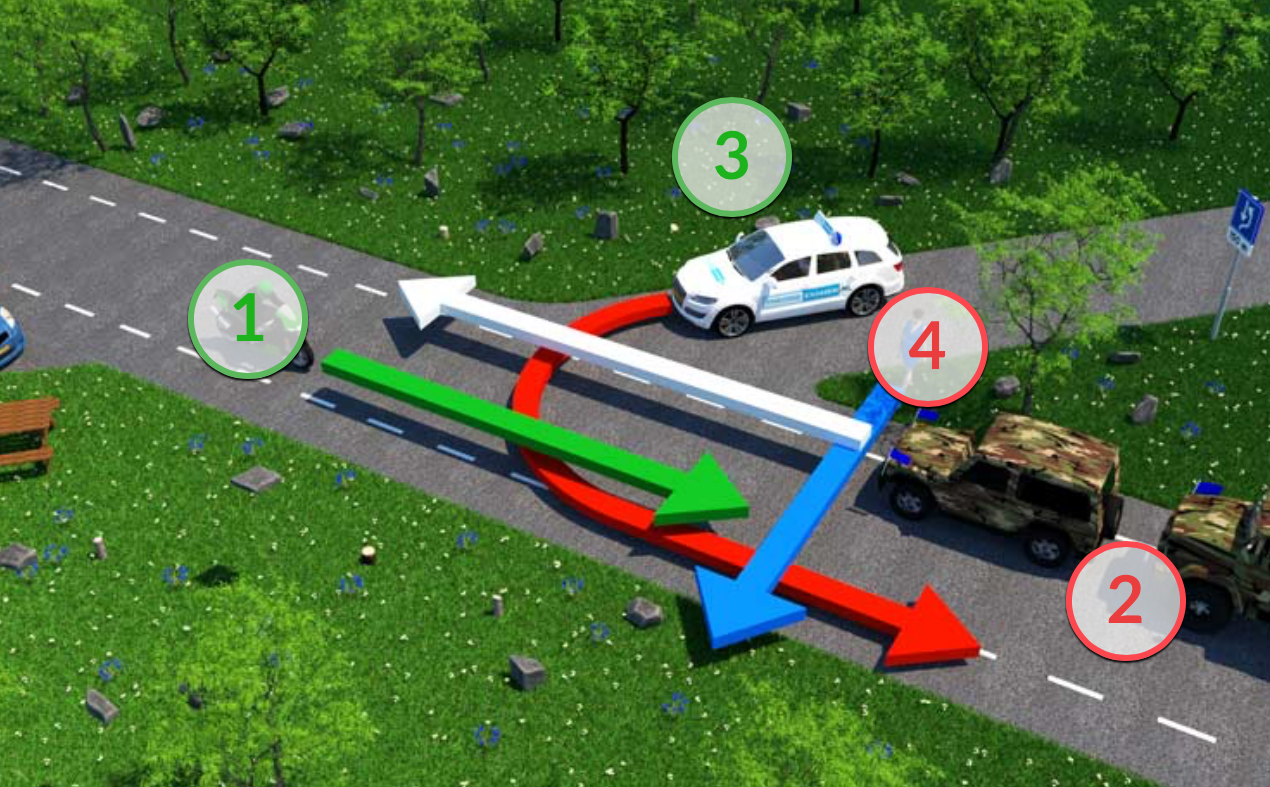
At priority uncontrolled junctions, drivers must give way to drivers approaching from the right. The horse rider must give way to the car that is approaching from the right. And the car has to give way to the moped rider, because a short turn has priority over a long turn. So the moped rider goes first, then the car and finally the horse rider.
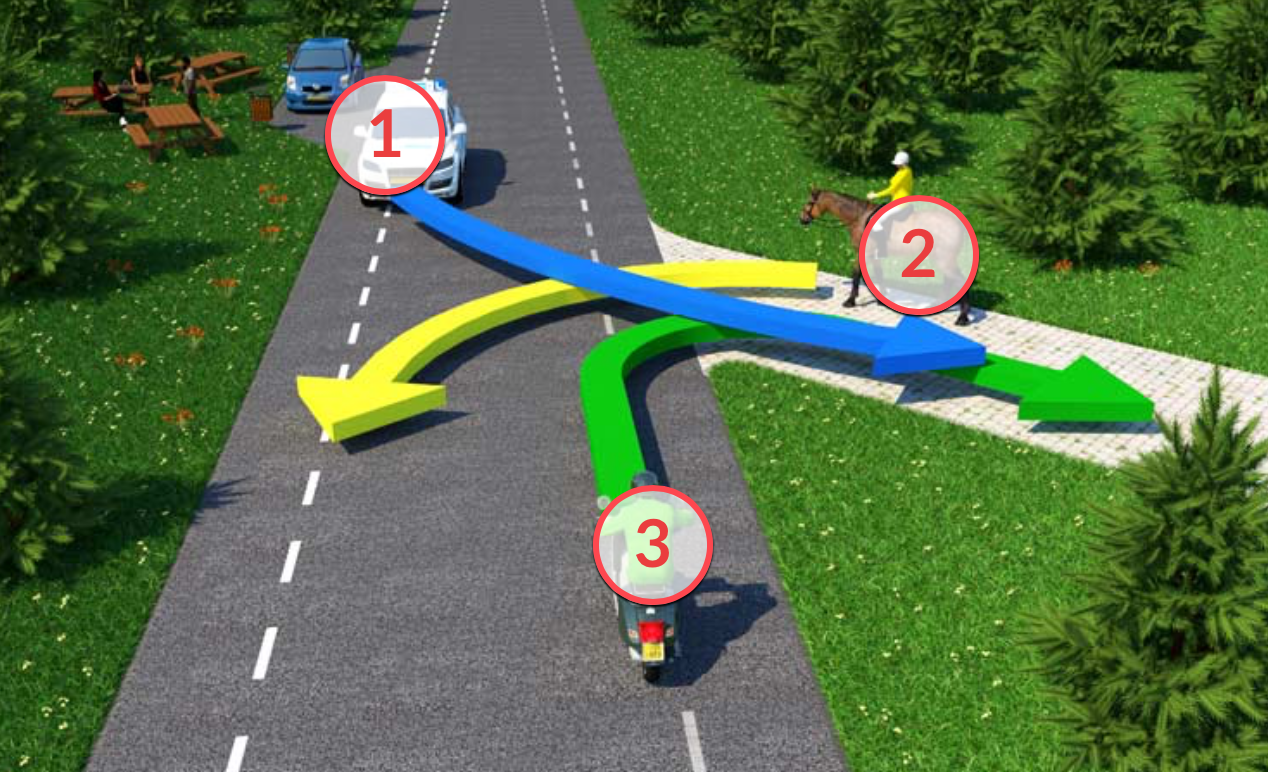
The traffic signs show that the car is driving on a priority road. The bottom plate indicates the direction of the priority road. The moped must give way to drivers on the priority road. The car continues to drive on the priority road and does not turn into a different road. The car does not have to give way to the pedestrian and goes first. The moped does make a turn and must give way to the pedestrian going straight. The pedestrian therefore may cross next and the moped goes last.
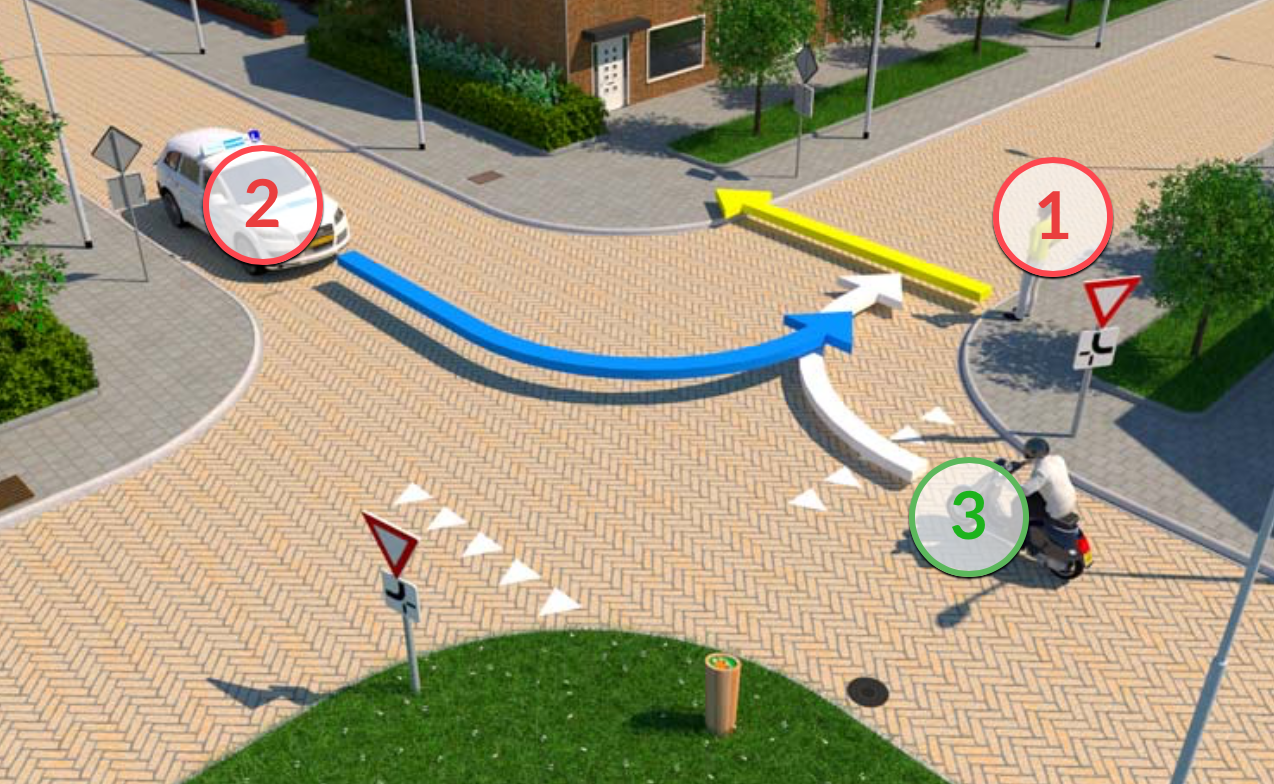
Moped, tractor, horse, car (not sure why if there’s a left turn involved by tractor: because car also turns left so it’s big turn vs. big turn)
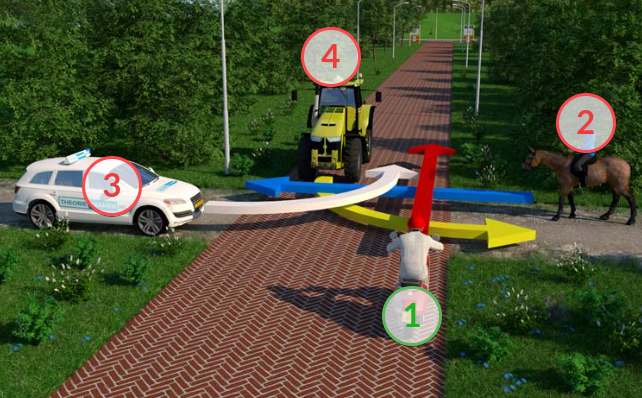
Warning: pedestrians around!
The traffic sign warns that pedestrians can cross or walk on the road.
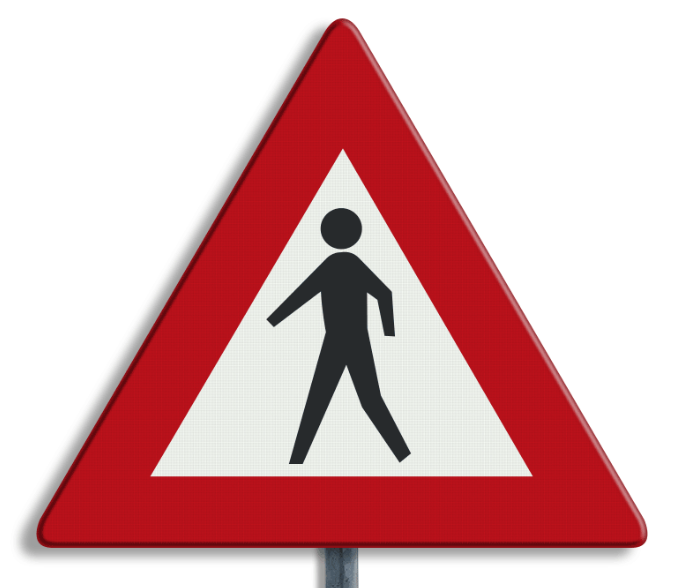
Cycle lanes & roundabout
This cycle lane is considered part of the roundabout, thus you have to give the priority to the cyclists.
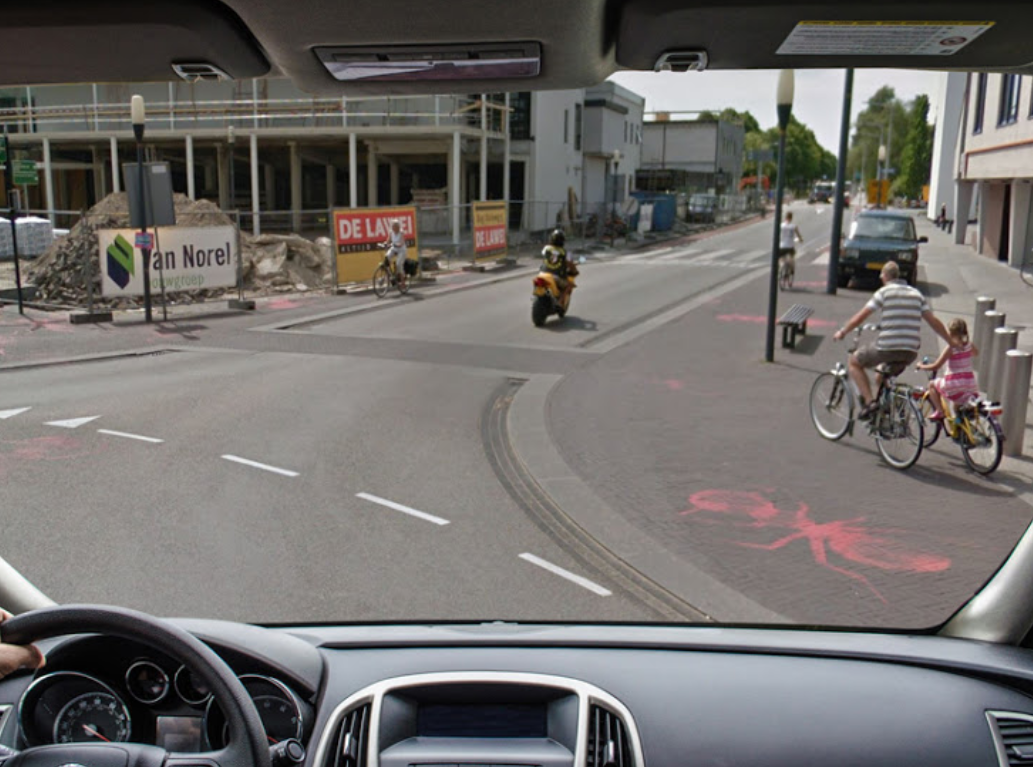
Hazard
Large signs means not-as-dangerous turn. 60kmh is fine here.
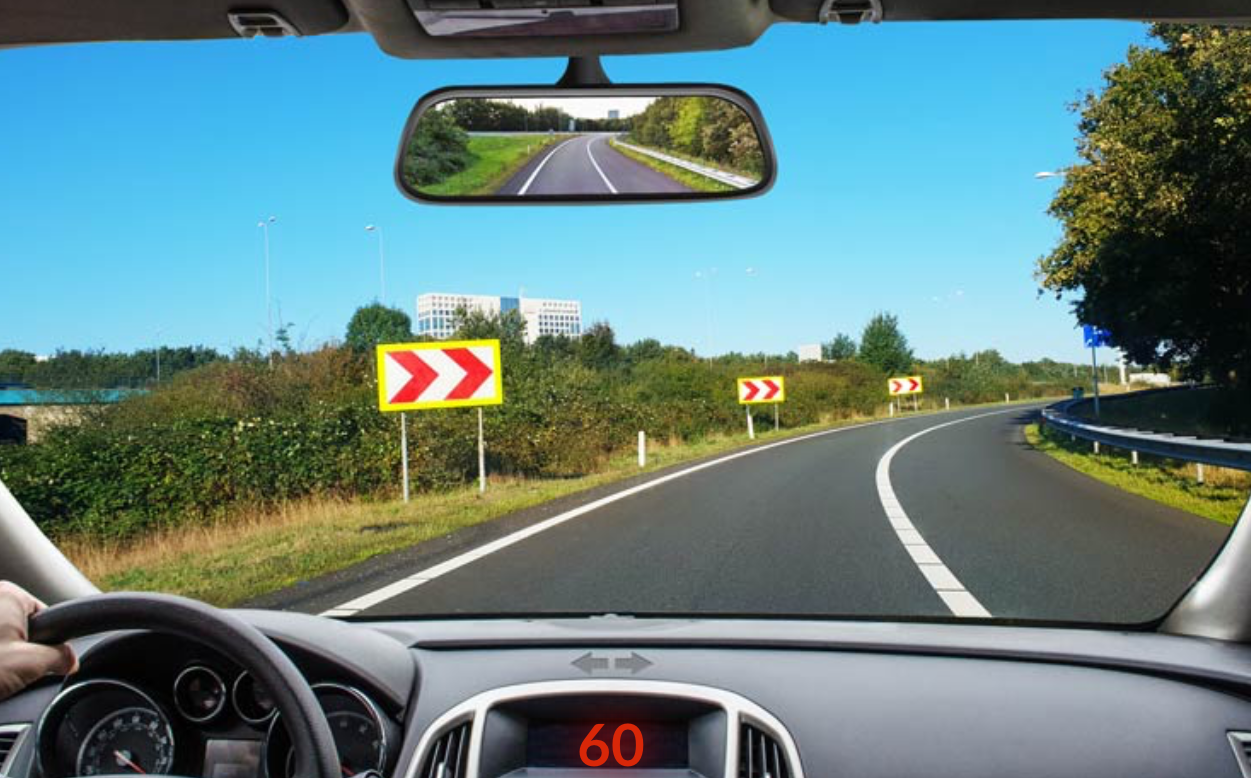
Verge
Drive at walking-speed only
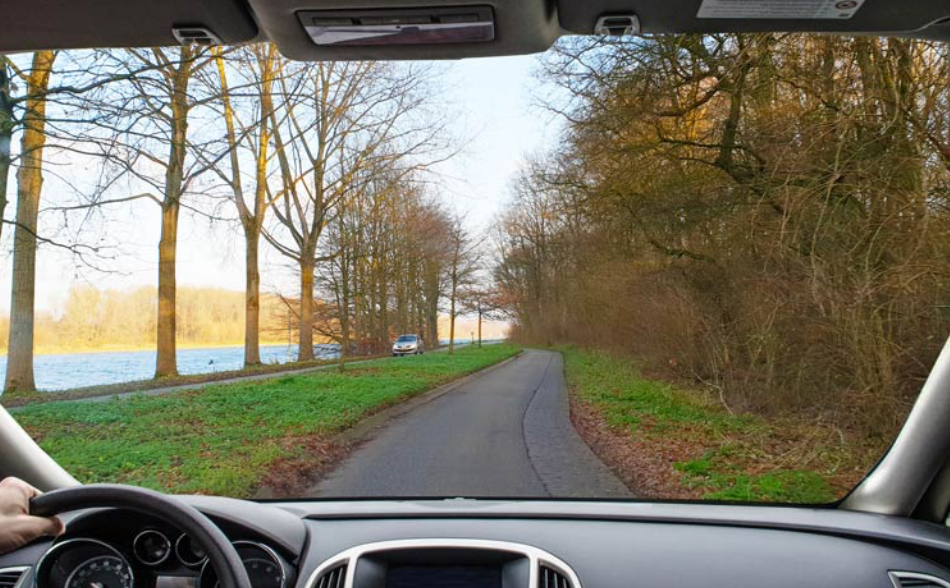
2023-12-01 11:08
First passed test
